jump start FORD RANGER 2002 2.G Owners Manual
[x] Cancel search | Manufacturer: FORD, Model Year: 2002, Model line: RANGER, Model: FORD RANGER 2002 2.GPages: 288, PDF Size: 3.03 MB
Page 2 of 288
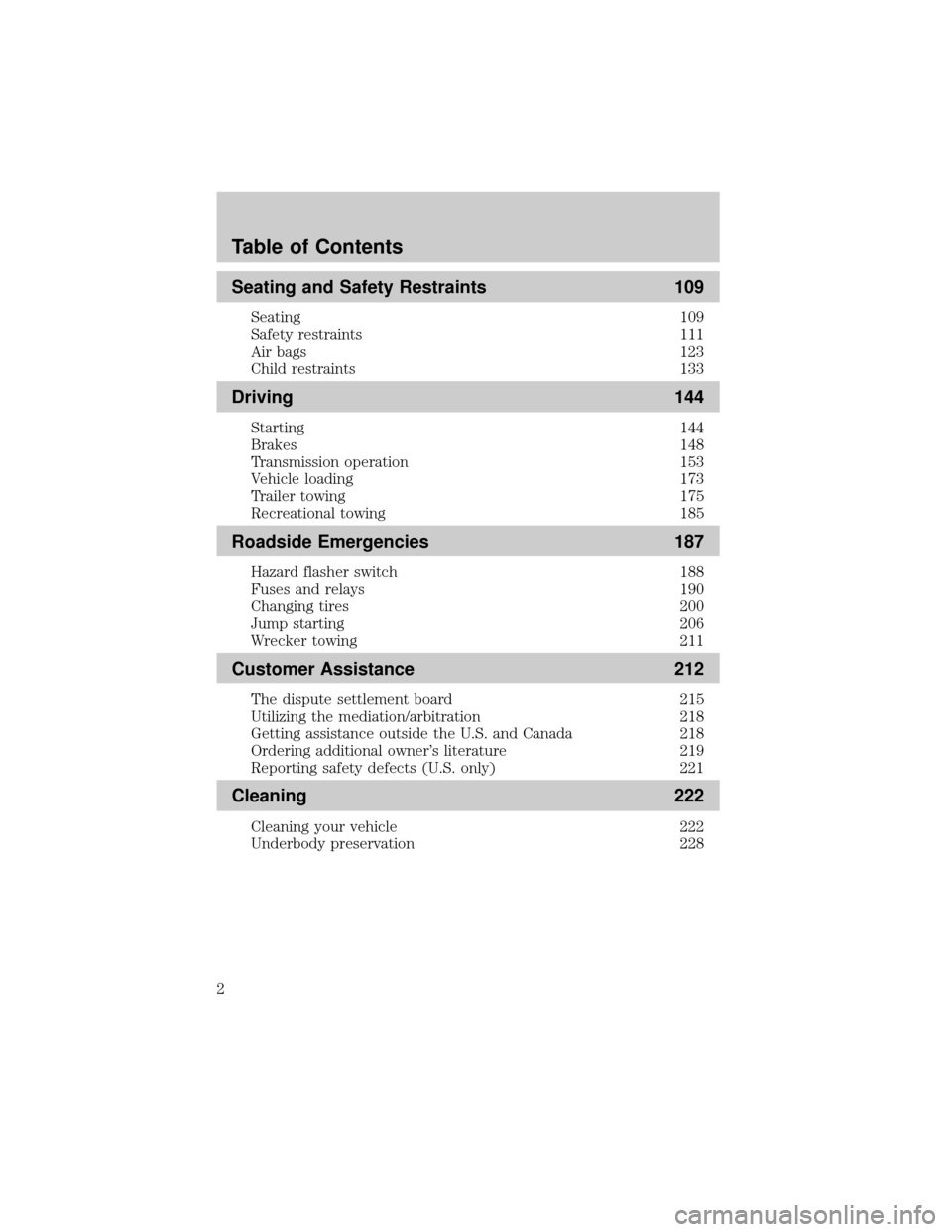
Seating and Safety Restraints 109
Seating 109
Safety restraints 111
Air bags 123
Child restraints 133
Driving 144
Starting 144
Brakes 148
Transmission operation 153
Vehicle loading 173
Trailer towing 175
Recreational towing 185
Roadside Emergencies 187
Hazard flasher switch 188
Fuses and relays 190
Changing tires 200
Jump starting 206
Wrecker towing 211
Customer Assistance 212
The dispute settlement board 215
Utilizing the mediation/arbitration 218
Getting assistance outside the U.S. and Canada 218
Ordering additional owner's literature 219
Reporting safety defects (U.S. only) 221
Cleaning 222
Cleaning your vehicle 222
Underbody preservation 228
Table of Contents
2
Page 187 of 288
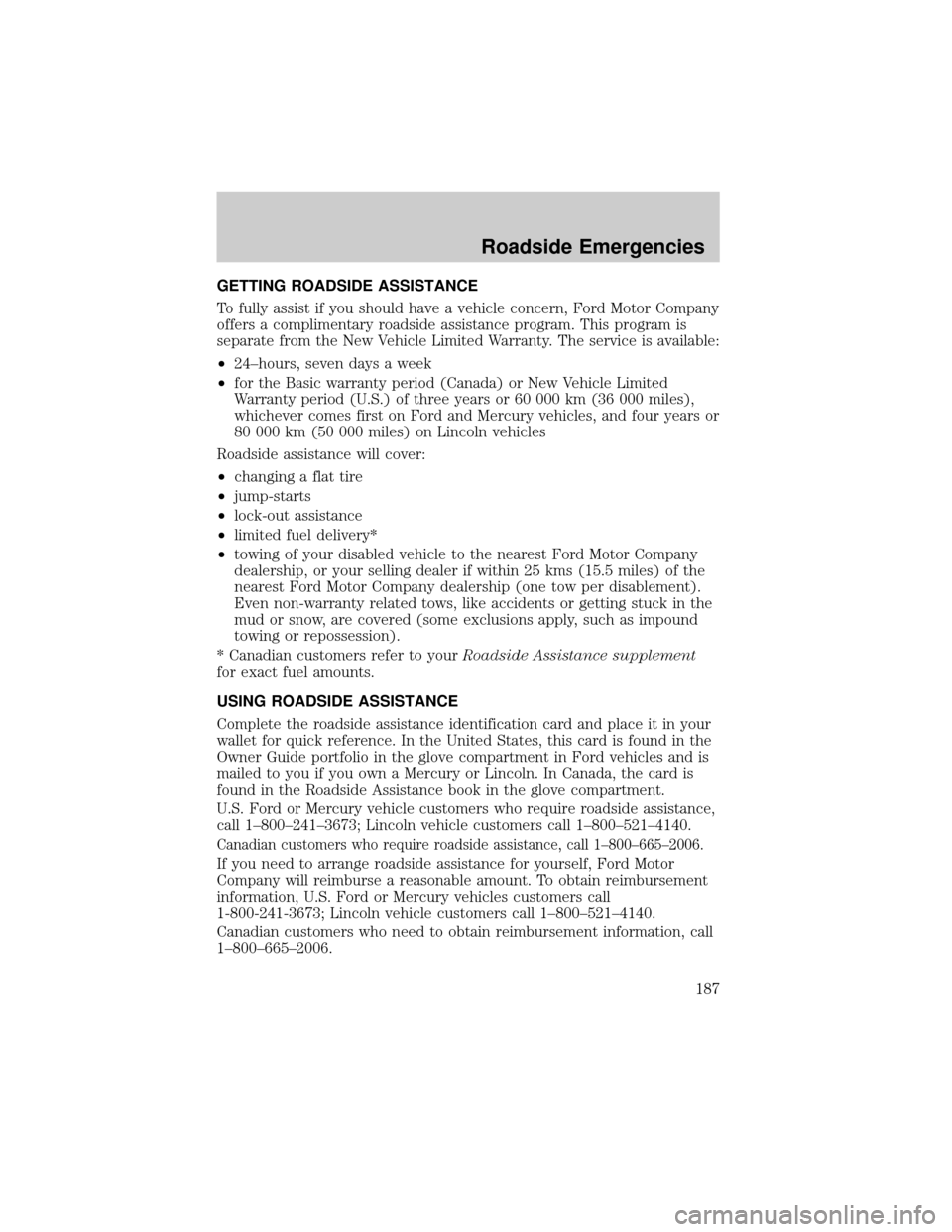
GETTING ROADSIDE ASSISTANCE
To fully assist if you should have a vehicle concern, Ford Motor Company
offers a complimentary roadside assistance program. This program is
separate from the New Vehicle Limited Warranty. The service is available:
²24±hours, seven days a week
²for the Basic warranty period (Canada) or New Vehicle Limited
Warranty period (U.S.) of three years or 60 000 km (36 000 miles),
whichever comes first on Ford and Mercury vehicles, and four years or
80 000 km (50 000 miles) on Lincoln vehicles
Roadside assistance will cover:
²changing a flat tire
²jump-starts
²lock-out assistance
²limited fuel delivery*
²towing of your disabled vehicle to the nearest Ford Motor Company
dealership, or your selling dealer if within 25 kms (15.5 miles) of the
nearest Ford Motor Company dealership (one tow per disablement).
Even non-warranty related tows, like accidents or getting stuck in the
mud or snow, are covered (some exclusions apply, such as impound
towing or repossession).
* Canadian customers refer to yourRoadside Assistance supplement
for exact fuel amounts.
USING ROADSIDE ASSISTANCE
Complete the roadside assistance identification card and place it in your
wallet for quick reference. In the United States, this card is found in the
Owner Guide portfolio in the glove compartment in Ford vehicles and is
mailed to you if you own a Mercury or Lincoln. In Canada, the card is
found in the Roadside Assistance book in the glove compartment.
U.S. Ford or Mercury vehicle customers who require roadside assistance,
call 1±800±241±3673; Lincoln vehicle customers call 1±800±521±4140.
Canadian customers who require roadside assistance, call 1±800±665±2006.
If you need to arrange roadside assistance for yourself, Ford Motor
Company will reimburse a reasonable amount. To obtain reimbursement
information, U.S. Ford or Mercury vehicles customers call
1-800-241-3673; Lincoln vehicle customers call 1±800±521±4140.
Canadian customers who need to obtain reimbursement information, call
1±800±665±2006.
Roadside Emergencies
187
Page 206 of 288
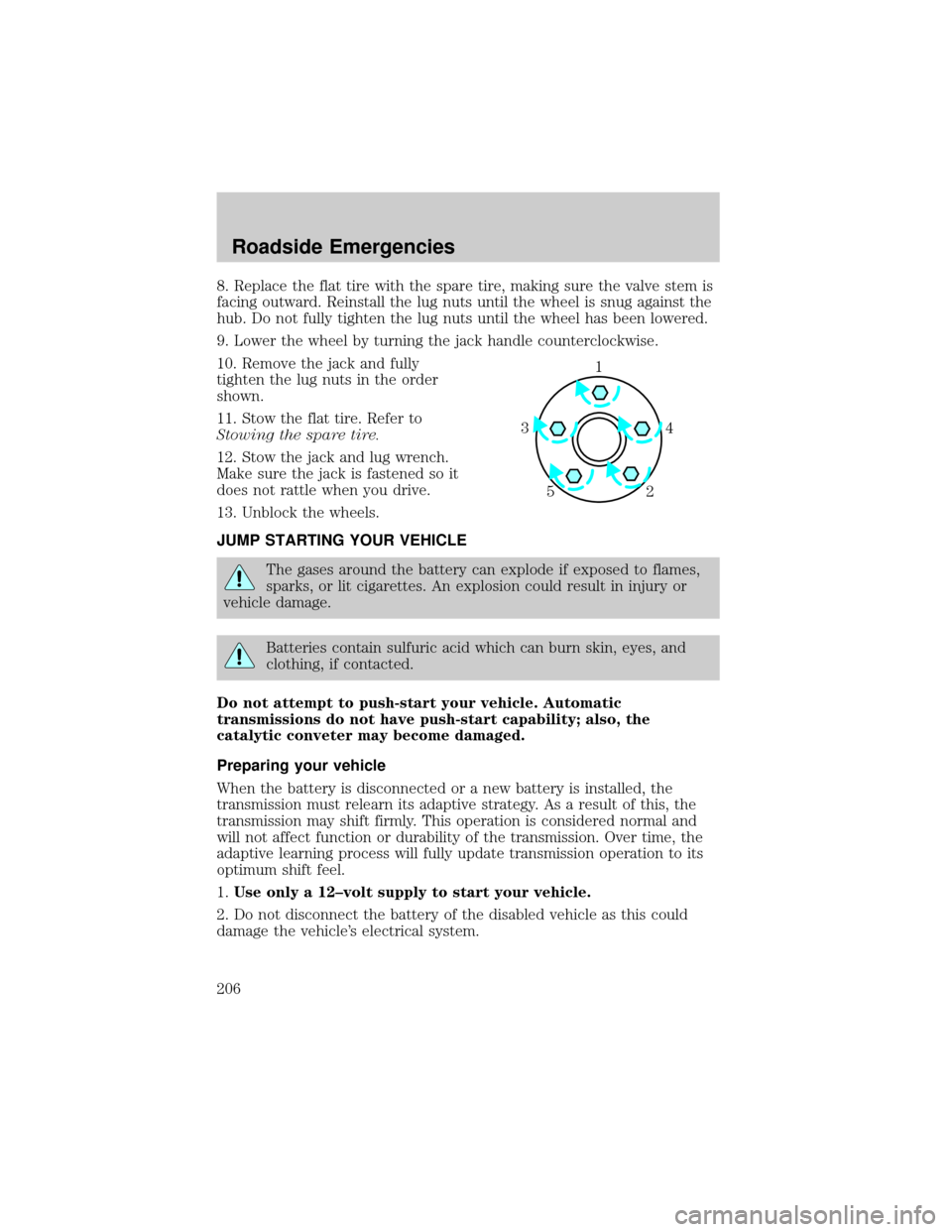
8. Replace the flat tire with the spare tire, making sure the valve stem is
facing outward. Reinstall the lug nuts until the wheel is snug against the
hub. Do not fully tighten the lug nuts until the wheel has been lowered.
9. Lower the wheel by turning the jack handle counterclockwise.
10. Remove the jack and fully
tighten the lug nuts in the order
shown.
11. Stow the flat tire. Refer to
Stowing the spare tire.
12. Stow the jack and lug wrench.
Make sure the jack is fastened so it
does not rattle when you drive.
13. Unblock the wheels.
JUMP STARTING YOUR VEHICLE
The gases around the battery can explode if exposed to flames,
sparks, or lit cigarettes. An explosion could result in injury or
vehicle damage.
Batteries contain sulfuric acid which can burn skin, eyes, and
clothing, if contacted.
Do not attempt to push-start your vehicle. Automatic
transmissions do not have push-start capability; also, the
catalytic conveter may become damaged.
Preparing your vehicle
When the battery is disconnected or a new battery is installed, the
transmission must relearn its adaptive strategy. As a result of this, the
transmission may shift firmly. This operation is considered normal and
will not affect function or durability of the transmission. Over time, the
adaptive learning process will fully update transmission operation to its
optimum shift feel.
1.Use only a 12±volt supply to start your vehicle.
2. Do not disconnect the battery of the disabled vehicle as this could
damage the vehicle's electrical system.
1
4 3
2 5
Roadside Emergencies
206
Page 209 of 288
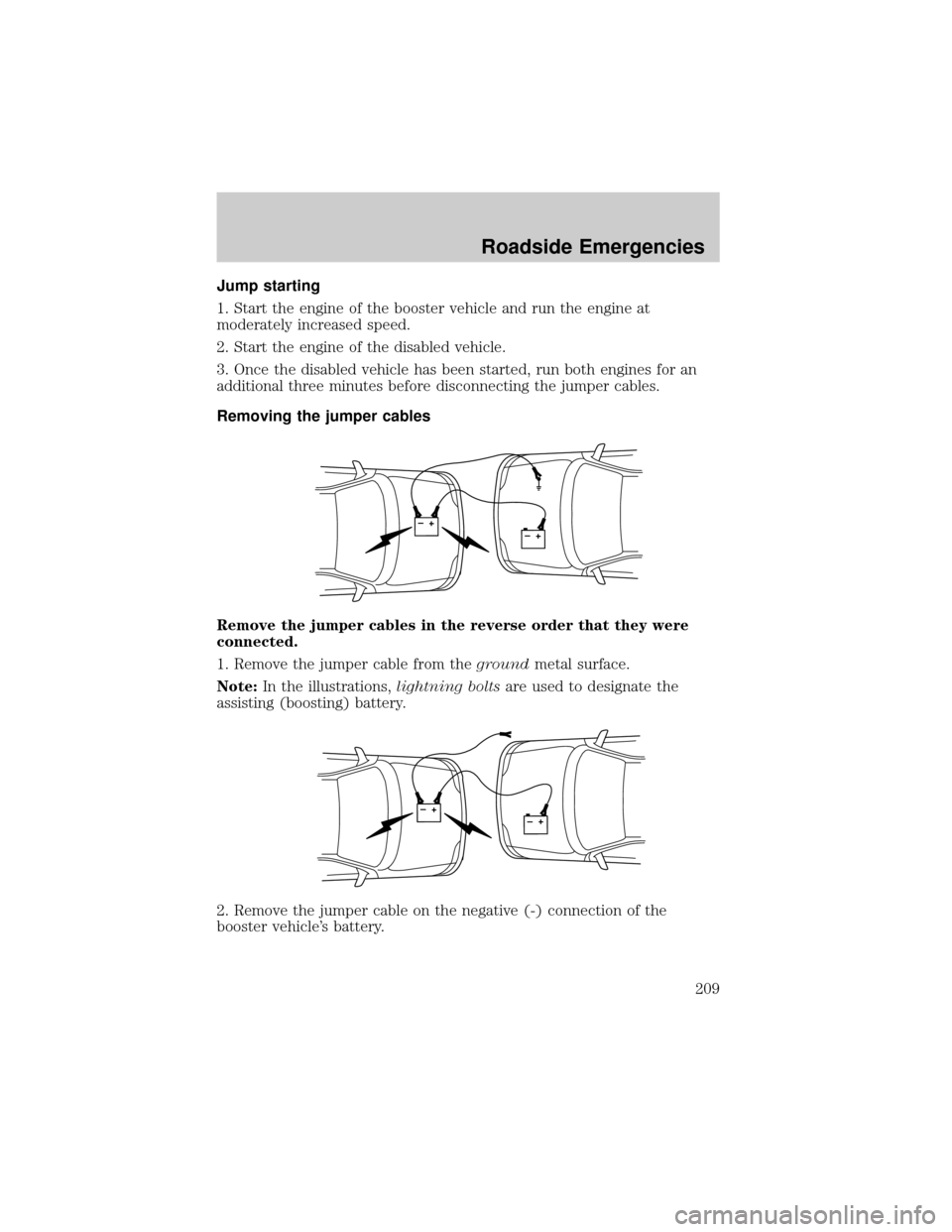
Jump starting
1. Start the engine of the booster vehicle and run the engine at
moderately increased speed.
2. Start the engine of the disabled vehicle.
3. Once the disabled vehicle has been started, run both engines for an
additional three minutes before disconnecting the jumper cables.
Removing the jumper cables
Remove the jumper cables in the reverse order that they were
connected.
1. Remove the jumper cable from thegroundmetal surface.
Note:In the illustrations,lightning boltsare used to designate the
assisting (boosting) battery.
2. Remove the jumper cable on the negative (-) connection of the
booster vehicle's battery.
+–+–
+–+–
Roadside Emergencies
209
Page 210 of 288
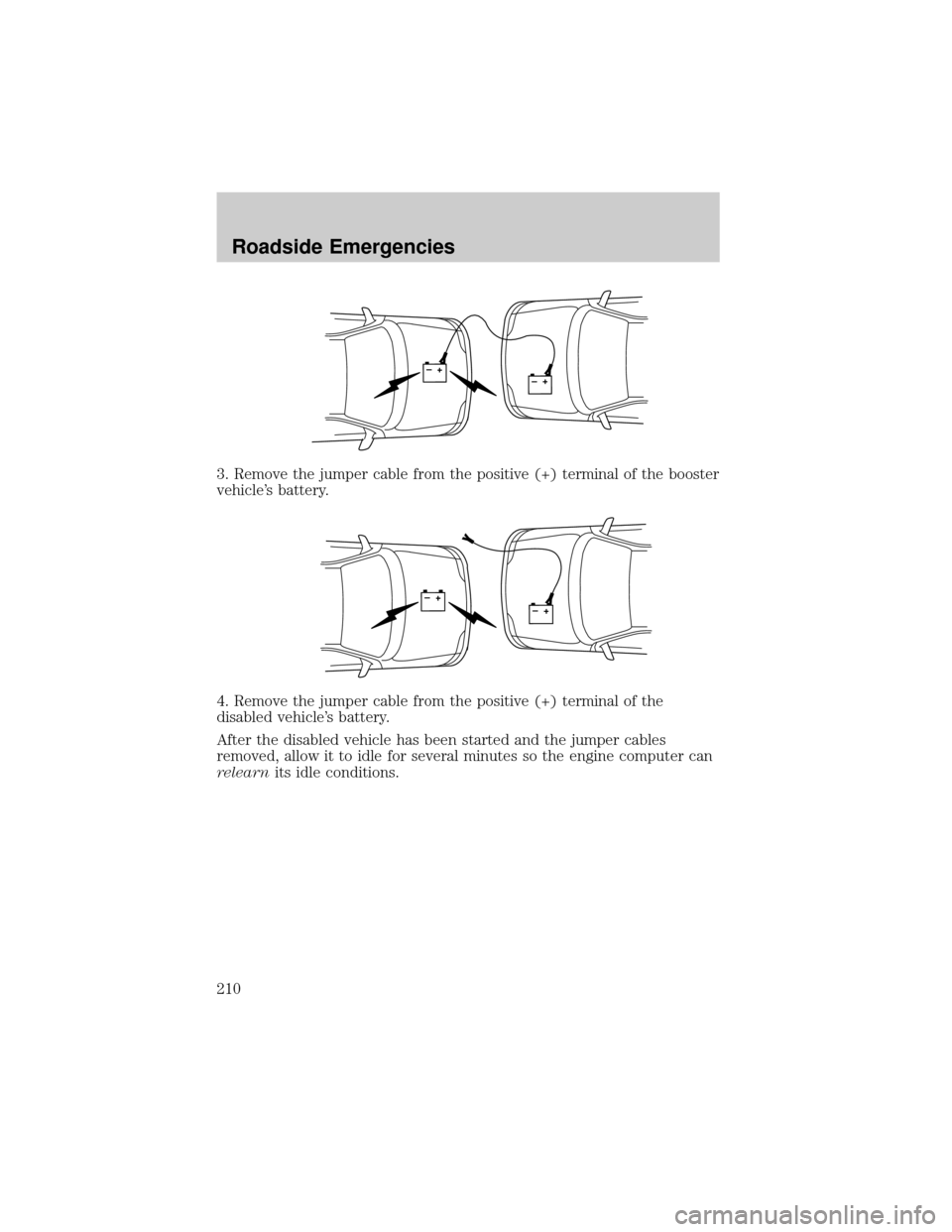
3. Remove the jumper cable from the positive (+) terminal of the booster
vehicle's battery.
4. Remove the jumper cable from the positive (+) terminal of the
disabled vehicle's battery.
After the disabled vehicle has been started and the jumper cables
removed, allow it to idle for several minutes so the engine computer can
relearnits idle conditions.
+–+–
+–+–
Roadside Emergencies
210
Page 284 of 288

Cleaning your vehicle
engine compartment ..............224
exterior ....................................228
instrument cluster lens ..........227
instrument panel ....................227
interior .....................................227
plastic parts ............................226
safety belts ..............................228
washing ....................................222
waxing .....................................222
wheels ......................................223
windows ..................................227
wiper blades ............................226
Clock ....................21, 28, 41, 50, 64
Clutch
fluid ..........................................261
operation while driving ..........157
recommended shift speeds ....159
Console ........................................92
Coolant
checking and adding ..............243
refill capacities ................248, 271
specifications ..................274, 276
Cruise control
(see Speed control) ....................87
Customer Assistance ................187
Ford accessories for your
vehicle .............................229, 280
Ford Extended Service
Plan ..........................................214
Getting assistance outside the
U.S. and Canada .....................218
Getting roadside assistance ...187
Getting the service you
need .........................................212
Ordering additional owner's
literature .................................219
The Dispute Settlement
Board .......................................215Utilizing the
Mediation/Arbitration
Program ...................................218
D
Daytime running lamps
(see Lamps) ................................73
Dipstick
automatic transmission
fluid ..........................................261
engine oil .................................236
Doors
door ajar warning .....................13
lubricant specifications ..........274
Driveline universal joint and
slip yoke ....................................265
Driving under special
conditions ..........................166, 169
sand .........................................167
snow and ice ...........................170
through water .................168, 173
E
Emergencies, roadside
jump-starting ..........................206
Emission control system ..........257
Engine ................................276±277
check engine/service engine
soon light ..................................10
cleaning ...................................224
coolant .....................................243
idle speed control ...................241
lubrication
specifications ..................274, 276
refill capacities ........................271
service points ..................232±234
starting after a collision .........188
Index
284
Page 286 of 288

flash to pass ..............................74
high beam ...........................13, 74
replacing bulbs .........................77
turning on and off ....................73
warning chime ..........................14
Heating
heater only system ...................68
heating and air conditioning
system .......................................70
Hood ..........................................231
I
Ignition .......................144, 276±277
Infant seats
(see Safety seats) .....................134
Inspection/maintenance (I/M)
testing ........................................258
Instrument panel
cleaning ...................................227
cluster ................................10, 227
lighting up panel and
interior .......................................74
J
Jack ............................................200
positioning .......................200, 204
storage .............................200±203
Jump-starting your vehicle ......206
K
Keys ...................................106, 108
key in ignition chime ...............14
positions of the ignition .........144L
Lamps
bulb replacement
specifications chart ..................76
cargo lamps ...............................74
daytime running light ...............73
fog lamps ...................................73
headlamps .................................73
headlamps, flash to pass ..........74
instrument panel, dimming .....74
interior lamps .....................75, 77
replacing bulbs .......75, 77, 79±82
Lane change indicator
(see Turn signal) ........................75
Lights, warning and indicator ....10
air bag ........................................12
anti-lock brakes (ABS) ....12, 150
anti-theft ...................................14
brake ..........................................11
charging system ........................12
check coolant ............................11
check engine .............................10
cruise indicator .........................13
door ajar ....................................13
fuel cap light .............................12
high beam .................................13
overdrive off ..............................13
safety belt .................................12
speed control ............................91
turn signal indicator .................13
Load limits .................................173
GAWR ......................................173
GVWR ......................................173
trailer towing ..........................173
Loading instructions .................175
Lubricant specifications ...274, 276
Lumbar support, seats .............110
Index
286
Page 288 of 288

Specification chart,
lubricants ...........................274, 276
Speed control ..............................87
Speedometer ...............................17
Starting your
vehicle ........................144±145, 147
jump starting ..........................206
Steering wheel
controls ................................84, 87
tilting .........................................84
T
Tachometer .................................17
Temperature control
(see Climate control) .................68
Tires ...........................200, 266±267
changing ..................200±201, 204
checking the pressure ............267
replacing ..................................269
rotating ....................................268
snow tires and chains ............269
tire grades ...............................267
treadwear ................................266
Tonneau cover .............................95
Towing .......................................175
recreational towing .................185
trailer towing ..........................175
wrecker ....................................211
Traction-lok rear axle ...............151
Transfer case
fluid checking .........................265
Transmission
automatic operation ...............153
fluid, checking and adding
(automatic) .............................261fluid, checking and adding
(manual) .................................264
fluid, refill capacities ..............271
lubricant specifications ..274, 276
manual operation ....................157
Trip odometer .............................17
Trunk .........................................100
Turn signal ............................13, 75
V
Vehicle dimensions ...................277
Vehicle Identification Number
(VIN) ..........................................279
Vehicle loading ..........................173
camper bodies ........................186
Ventilating your vehicle ...........148
W
Warning chimes ...........................14
Warning lights (see Lights) .......10
Washer fluid ..............................235
Water, Driving through .............173
Windows
power .........................................86
Windshield washer fluid and
wipers
checking and adding fluid .....235
checking and cleaning ..............83
operation ...................................83
replacing wiper blades .............84
Wrecker towing .........................211
Index
288